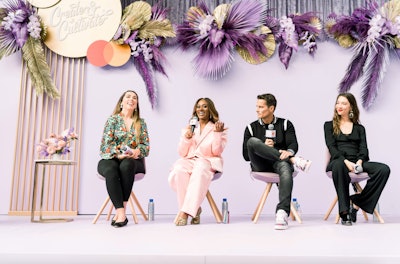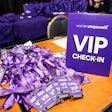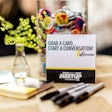
It’s the eternal challenge for event planners: How do you keep sponsors happy without sacrificing an event’s quality and integrity? From prioritizing authenticity to setting boundaries, we asked event professionals to share their top strategies for creating seamless sponsor experiences that enhance rather than overshadow the main event. Here are their top tips.
1. Be upfront about your event’s vision and boundaries.
Establishing clear expectations from the start is crucial to maintaining both sponsor satisfaction and event integrity. “Communication and managing expectations is critical to successful sponsor relationships,” says Jackie Hershfeld, events director at Baltimore magazine. “The sooner you can have a conversation and establish what your sponsors' goals are and the ROI they are looking to achieve, and gain clarity around what would make this a successful event for both of you, the happier both parties will be and the likelihood of their return participation exponentially increases.”Leslie Jespersen, founder of Leveled Up Events, also stresses the importance of honest, in-depth conversations at the start. "Before you take any sponsor's money, ask them what their goals and expectations are for the event. Understanding their vision helps you get creative and find ways to meet both their needs and the event's integrity," she says.
One example Jespersen recalls involves an alcohol-based sponsor looking to support one of her typically alcohol-free events. Instead of declining outright, she devised a creative solution: including a can of the sponsor’s product in the swag bags for guests to enjoy later. "We also gave the founder a chance to share her origin story, allowing the brand to get exposure while staying aligned with the event’s atmosphere," she explains. "This way, both parties were happy and the brand still received the spotlight, just in a way that respected the event's goals."
2. It's all about finding common ground.
"Our approach always starts with alignment—not just brand alignment, but values, tone, audience expectations, and the overall goals of the event and the sponsor," explains Tara Reilly, vice president of experiential and partnerships for Vox Media, who always asks herself: "Does this add to the experience for our audience?""If the answer isn’t a resounding yes, we go back to the drawing board," she notes. "Whether it’s co-creating a custom moment, embedding product into an editorial experience, or designing a utility that genuinely enhances the attendee journey, it must feel native to the environment and emotionally intelligent."  "We love when sponsors give us a strong creative foundation to design experiences that feel immersive and purposeful, not promotional," says Reilly. "At the Vulture Spot at Sundance Film Festival—Vulture’s talent-facing editorial studio—we were intentional about allowing each sponsor to show up in a way that felt authentic to their brand while enhancing the overall Vulture experience. Paramount+’s Yellowjackets leaned into its dark, cult-favorite tone with a lounge (pictured) and F&B moments designed to reflect the show’s world. La Mer brought a contrasting energy with a luxe treatment and gifting experience. Each activation felt distinct, but together they elevated the space and made the experience more dynamic and memorable—not more commercial."Photo: Courtesy of Vox Media
"We love when sponsors give us a strong creative foundation to design experiences that feel immersive and purposeful, not promotional," says Reilly. "At the Vulture Spot at Sundance Film Festival—Vulture’s talent-facing editorial studio—we were intentional about allowing each sponsor to show up in a way that felt authentic to their brand while enhancing the overall Vulture experience. Paramount+’s Yellowjackets leaned into its dark, cult-favorite tone with a lounge (pictured) and F&B moments designed to reflect the show’s world. La Mer brought a contrasting energy with a luxe treatment and gifting experience. Each activation felt distinct, but together they elevated the space and made the experience more dynamic and memorable—not more commercial."Photo: Courtesy of Vox Media
Sometimes, saying no is necessary. Isabella Rodriguez, co-founder of experiential marketing firm Super Great Fantastic, advises being willing to walk away when a sponsor’s vision doesn’t align with the event’s purpose. "If a sponsor does not meet our goals and is not willing to adapt to the event, then we simply tell them it’s not the right fit. Our sponsors are meant to elevate the experience, not dominate it—and in turn, we elevate their impact with guests."
3. Prioritize authenticity.
The best sponsorships feel organic rather than commercial. Tom Crichton, head of sponsorship at Events.com, explains: “When you align what a sponsor does with what eventgoers already love about the experience, it becomes something people actually want to engage with."The best-performing sponsor activations invite people into something unexpected, Crichton adds. “The goal is to spark genuine moments, whether that's someone discovering a new product, snapping a photo, or just having a good time with friends,” he says. “That kind of interaction builds goodwill, creates memories, and opens the door to the sponsor’s message in a way that doesn’t feel forced or overly commercial.”
Katie Meyer, CEO and director of events at MoonLab Productions, agrees. “Our goal, as with any event we produce, is to create moments that feel organic and genuinely add value.” One effective strategy Meyer uses is to turn product features into hands-on activations—like a wellness lounge powered by a skincare brand, or a recharge station powered by a tech brand.
"This way, attendees are experiencing the sponsor and their product, creating a more memorable and authentic connection," she adds. “Breakout zones and speaker sessions that align with both the sponsor’s mission and the client’s goals resonate much more deeply.”
4. Focus on moments that enhance the experience, rather than just displaying logos.
"The most meaningful brand activations don’t just show up—they offer something of value," says Reilly. "They enhance the experience in a way that feels intentional and considered, whether through a moment of comfort, discovery, creativity, or connection. When a brand responds to a real need and does so in a way that feels true to who they are, it resonates."“Attendees naturally tend to gravitate toward touchpoints that feel more integrated and are meaningful rather than overly promotional,” agrees Meyer. “Those are the moments that lead to stronger brand recall."
Go beyond just slapping a bunch of logos on your signage, suggest Rodriguez. “We have them sponsor the entertainment, a passed appetizer, a signature cocktail,” she says. For an upcoming event at Cannes Lions, for example, Rodriguez is looking into having a caviar sponsor come in for passed caviar bumps. “This brings the impact of a sponsor to our guests in a very tactile manner,” she notes. “It’s more than seeing their name in lights; it's about people leaving with a memory of the experience they enhanced.”
5. Use functional touchpoints for subtle branding moments.
For Rick Newman, CEO of UCON Exhibitions, it’s all about working sponsors into the attendee journey. “I usually assign them functional touchpoints (like branded charging stations, water refill bars, or even a concierge desk) where attendees genuinely benefit,” he says. “When the activation does something useful, no one complains about logos. It becomes part of the memory, not an interruption.”Jespersen likes to lean into “bathroom takeover” sponsorships. “The brand gets to put empowering messages on the mirrors, leave their collateral in the amenities baskets, and fully brand the bathroom space,” she explains. “Attendees love the unexpected little touches, and the sponsor gets meaningful exposure in a way that doesn’t disrupt the flow of the event.”
Remember that sponsors can touch on all aspects of the attendee journey, adds Hershfeld. “For sponsors that are less activation-based, we’re able to highlight them on multiple platforms while advertising the event. This promotion ahead of the event has some of the greatest impact as you’re not only reaching the event attendee but our entire audience,” she explains. “Ultimately, it comes back to your event vision and what’s most aligned."
6. Maintain balance in content sessions.
While there can certainly be a place for sponsored content sessions, it should be carefully weighed with the value the event is promising attendees. “We once pulled a $35,000 sponsor slot because they tried to rewrite a session title to match their campaign slogan,” remembers Newman. “I told them flat out we would rather refund the money than lose the credibility. They came back next year with a better pitch!”When planning a sponsored content session, focus on delivering value to attendees rather than allowing it to become a simple sales pitch. Start by asking the sponsor who they envision speaking and what topics they can authentically contribute to. Then, work together to strike a balance—crafting content that is both useful and engaging for attendees while also showcasing the sponsor in a positive, relevant way.
Ian Hawkins, a presenter and keynote speaker who often moderates sponsored content sessions, finds that having the sponsor be interviewed, rather than just having them deliver a speech, helps here. “An independent presenter gives the event a vibe of integrity and cutting through the sales pitch,” he says. “Obviously you can’t give sponsors a hard time, but they should know that it isn’t my job to sell their brand—it’s to give voice to the audience’s reasonable questions.”
7. Be collaborative when ideas don't fit.
"When a sponsor’s ask doesn’t quite align with the spirit of the event or feels like it might disrupt the audience experience, we approach it as a chance to collaborate and realign," says Reilly. "Rather than flatly saying no, we focus on the why—why it might not land well, and how that could ultimately affect both their goals and ours. Then we shift into solution mode, offering creative alternatives that preserve the integrity of the event while still delivering meaningful brand impact."In Reilly's experience, sponsors value that kind of transparency. "They don’t want to feel out of sync with the moment either. More often than not, those honest conversations lead to smarter, more thoughtful integrations that actually perform better."
Newman recalls a moment when a sponsor wanted to incorporate a video ad in the middle of a keynote speech. Instead, he offered the sponsor a curated lounge with a silent loop playing the content on LED tiles instead. “We had 1,200 attendees at that conference. About 700 visited that lounge,” he recalls. “That was a better outcome for everyone than a forced ad break. They got impressions, we kept the show intact.”
Newman’s advice for pushing back? “Draft hard rules early,” he says. “Spell out your integrity ceiling in the first pitch deck. ... Build the event strong first—then let sponsors decorate without tearing it down.”
8. Focus on building long-term sponsor relationships.
Establishing strong, ongoing partnerships with sponsors can make future collaborations smoother. "Be willing to put in the time to build a relationship with sponsors so that you can get clear on their goals for participating in your event,” Hershfeld says. “Beyond that, document everything: Have a checklist of all necessary deliverables, share that with your sales team, and have it available for your sponsors.”Managing sponsors can often be a full-time job, she adds, “so the better the relationships you can build with your sponsors, the more sponsors that provide you with return business—this is where everyone is able to flourish and grow!”
It's all about working together to find shared objectives, and to understand what truly matters to the sponsor—whether it's awareness, perception, product sales, or engagement, notes Reilly. "Be the translator between your audience and the brand. And remember: You don’t have to compromise on storytelling or guest experience to make a sponsor happy. In fact, the most successful partnerships are the ones where both sides feel proud of the outcome. Integrity isn’t a constraint—it’s your differentiator."



















